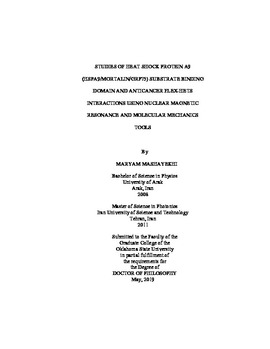| dc.contributor.advisor | Zhou, Donghua H. | |
| dc.contributor.author | Mashayekhi, Maryam | |
| dc.date.accessioned | 2019-10-25T19:51:37Z | |
| dc.date.available | 2019-10-25T19:51:37Z | |
| dc.date.issued | 2019-05-01 | |
| dc.identifier.uri | https://hdl.handle.net/11244/321552 | |
| dc.description.abstract | Ovarian cancer is the most life-threatening of all gynecologic malignancies with survival rate of about 30% that often has few symptoms prior to late stage diagnosis. Ovarian cancer causes 5 percent of cancer deaths among US women. In 2018 approximately 22,240 new cases of ovarian cancer were diagnosed in the United States and 14,070 died. Cisplatin and taxane drugs usually have unacceptable side effects. SHetA2 is an anticancer compound that has exhibited strong activity against ovarian cancer. It has discriminatory activity against malignant cells versus normal cells and has very low toxicity. SHetA2 is a sulfur containing Flex-Het with the highest anti-cancer activity among the tested Flex-Hets. SHetA2 has been shown effective against all of over 60 cancer cell lines in the US National Cancer Institute. SHetA2 interacts with heat shock protein HSPA9/mortalin. Mortalin was shown to associate with the tumor protein p53 in a concentration-dependent manner and leads to inactivation of p53 apoptotic function in stressed cells. Since p53 has a major role in cell cycle arrest and apoptosis, the loss of p53 function leads to immortalization of cells. Protein p53 is nonfunctional in some tumors by cytoplasmic sequestration of its binding proteins, such as Bcl-2, hsp70/mortalin, Parc, PML, and cytoskeleton proteins. One pathway for the compounds to inhibit the growth of cancer cells in vitro is by displacing p53 from mortalin. Then, p53 migrates to the nucleus and initiates apoptosis. Binding of SHetA2 to mortalin interrupts p53-mortalin interaction, and releases protein p53 to nucleus where it initiates apoptosis. Study of the interactions between mortalin and SHetA2 as well as the interactions between mortalin and SHetA2 analogs is the subject of this study. We used solution state NMR spectroscopy technique (chemical perturbation method) and molecular mechanics approaches (Autodock tools and molecular dynamics via GROMACS) to study protein-ligand interactions. We investigate the binding site and binding affinity using these techniques. Our findings helped designing improved SHetA2 analogs that were tested for their biological activities. | |
| dc.format | application/pdf | |
| dc.language | en_US | |
| dc.rights | Copyright is held by the author who has granted the Oklahoma State University Library the non-exclusive right to share this material in its institutional repository. Contact Digital Library Services at lib-dls@okstate.edu or 405-744-9161 for the permission policy on the use, reproduction or distribution of this material. | |
| dc.title | Studies of Heat Shock Protein A9 (HSPA9/Mortalin/Grp75) Substrate Binding Domain and Anticancer Flex-Hets Interactions Using Nuclear Magnetic Resonance and Molecular Mechanics Tools | |
| dc.contributor.committeeMember | Borunda, Mario F. | |
| dc.contributor.committeeMember | Summy, Gil | |
| dc.contributor.committeeMember | Deng, Junpeng | |
| osu.filename | Mashayekhi_okstate_0664D_16106.pdf | |
| osu.accesstype | Open Access | |
| dc.type.genre | Dissertation | |
| dc.type.material | Text | |
| dc.subject.keywords | anticancer | |
| dc.subject.keywords | heteroarotinoids | |
| dc.subject.keywords | mortalin | |
| dc.subject.keywords | nmr spectroscopy | |
| dc.subject.keywords | sheta2 | |
| dc.subject.keywords | structural drug design | |
| thesis.degree.discipline | Photonics | |
| thesis.degree.grantor | Oklahoma State University | |
